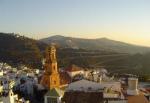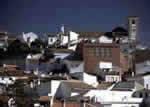| Essential Competa Information | Competa Bars & Restaurants |
Competa Photos |
Competa History
 All tourism slogans and campaigns, some more than others, are inspired by a reality that is more or less verifiable, and the traveller determines the veracity of the slogan during his visit to the area in question. In the case of Cómpeta, no one can doubt that the nickname “Cornisa del Mediterráneo” (“Cornice of the Mediterranean”) fits this locality like a glove. Indeed, the white of the town’s buildings juts out against a landscape that is overlooked by the great heights of the Tejeda and Almijara mountain ranges and stretches out in quest of the Mediterranean over a hilly country covered with the grapevines that yield its famous wine. One of the most representative images that the visitor will retain of La Axarquía will certainly be that provided by this municipality.This is a municipality that, like so many others of the province of Málaga, has no documented history until the fifteenth century, but considering the characteristics of the territory-abundant water, mountain refuges, pleasant temperatures and its status as a link between the provinces of Granada and Málaga-it seems probable that it contained human settlements in prehistoric times. At this time, though, there are no archaeological finds to support this hypothesis.Cómpeta appears by name in written records for the first time in 1487, when the corregidor (magistrate) of Vélez, which by then was in the hands of the Christians, urged the population to submit to the new owners. This indicates that until that date the place must have been no more than a farming community.The Moriscos (Moors) of Cómpeta, like most of those in La Axarquía, joined those that had already risen up and established strongholds in Peñón de Frigiliana –a place that was linked in the sixteenth century and ever afterwards to the history of La Axarquía by the part it was to play- until the Christian troops overcame the Moorish resistance on 12 June 1569.Although there were numerous casualties among the defenders, some escaped and continued to harass the Christians wherever they least expected it, but not for very long.The town was practically abandoned and was repopulated by long-time Christians from Puente Genil, Estepa, Baena, Seville and other localities that had already been retaken from the Muslims. The document from the first marriage contracted between established Christians in the town is preserved in the parish church. The year was 1573.
All tourism slogans and campaigns, some more than others, are inspired by a reality that is more or less verifiable, and the traveller determines the veracity of the slogan during his visit to the area in question. In the case of Cómpeta, no one can doubt that the nickname “Cornisa del Mediterráneo” (“Cornice of the Mediterranean”) fits this locality like a glove. Indeed, the white of the town’s buildings juts out against a landscape that is overlooked by the great heights of the Tejeda and Almijara mountain ranges and stretches out in quest of the Mediterranean over a hilly country covered with the grapevines that yield its famous wine. One of the most representative images that the visitor will retain of La Axarquía will certainly be that provided by this municipality.This is a municipality that, like so many others of the province of Málaga, has no documented history until the fifteenth century, but considering the characteristics of the territory-abundant water, mountain refuges, pleasant temperatures and its status as a link between the provinces of Granada and Málaga-it seems probable that it contained human settlements in prehistoric times. At this time, though, there are no archaeological finds to support this hypothesis.Cómpeta appears by name in written records for the first time in 1487, when the corregidor (magistrate) of Vélez, which by then was in the hands of the Christians, urged the population to submit to the new owners. This indicates that until that date the place must have been no more than a farming community.The Moriscos (Moors) of Cómpeta, like most of those in La Axarquía, joined those that had already risen up and established strongholds in Peñón de Frigiliana –a place that was linked in the sixteenth century and ever afterwards to the history of La Axarquía by the part it was to play- until the Christian troops overcame the Moorish resistance on 12 June 1569.Although there were numerous casualties among the defenders, some escaped and continued to harass the Christians wherever they least expected it, but not for very long.The town was practically abandoned and was repopulated by long-time Christians from Puente Genil, Estepa, Baena, Seville and other localities that had already been retaken from the Muslims. The document from the first marriage contracted between established Christians in the town is preserved in the parish church. The year was 1573.
 |
 |
 |
| Surface Area: | 54.7 square kilometres |
| Population: | about 4,000 |
| What the natives are called: | Competeños |
| Monuments: | Nuestra Señora de la Asunción church, hermitages of San Antón and San Sebastián |
| Geographical Location: | in the north-eastern La Axarquía region, on the slopes of the Sierra de Almijara. It is 28 kilometres from Vélez Málaga and 52 from the provincial capital. The urban zone sits at 640 meters above sea level. The area records an average annual rainfall of 630 litres per square metre, and the average temperature is 17.5º C |



















